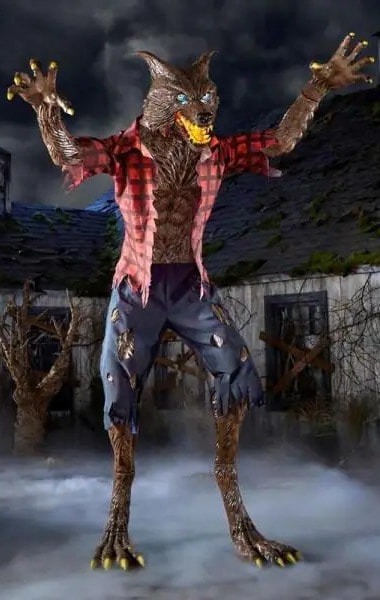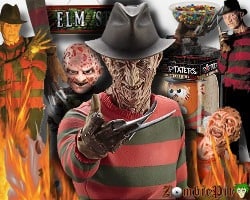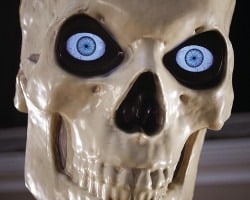Animatronic Werewolf Lifesize
- Realistic LCD moving eyes
- Head, Eye & Jaw Movements
- Spooky Sounds, Motion Sensor
- Assembly: 60 minutes with 2 adults
- Stake and Stand, Plug-in for Power
- Assembled: 9.5ft tall
- Indoors & Outdoors
Animatronic Werewolf Lifesize

Monster Moves
This 9ft 6″ animated Howling Werewolf with LifeEyes has a few extra features that place him head and scary shoulders above all the other werewolves. For starters, he is over nine feet tall! Whats more, Wolfie has some great moves and some spooky sounds to go with it. He tips his head and moves his jaws as he howls and snarls. Orange LEDs enhance a creepy ambience during the night to keep unsuspecting visitors on their toes. Add to this the occasional blood curdling howl and you have one scary werewolf in your home.
Life like Eyes
One of the great features of this animatronic lifesize werewolf are his super scary eyes. LCD LifeEyesTM technology really brings this beast to life, giving the appearance of movement and blinking that make it seem like he is alive and eyeing you up for dinner. Come sun-down, Wolfie’s eyes pierce the darkness, striking terror into the hearts of all those who come within range.
Description
Your animated lifesize werewolf stands firmly on a solid frame. From his freaky feet to his haunting head he looks every inch a real life terrifying werewolf, especially when he starts to howl. His feet and hands have sharp looking nails that create a chilling sight.
Blue trousers sit underneath a tattered shirt which has rips and tears that show his werewolf torso beneath. Wolfie’s crowning glory is his werewolf head. With illuminated rotting teeth, life-like eyes and permanent grimace, this is one realistic scary werewolf.
Motion Sensor Option
This animatronic lifesize werewolf can either be switched to full activity all the time but it also has a motion sensor option. This means he only bursts into life, growling and howling when somebody comes within range and trips the sensor. Setting Wolfie to motion sensor mode is probably the most fun. Watching unsuspecting guests jump out of their skin when wolfie springs to life, never gets old.
Verdict
This has to be the best animatronic lifesize werewolf out there. He’s big, intimidating, lifelife, well made and durable. When Wolfie growls and howls he looks incredibly realistic especially because of the LifeEyes technology. This nine and a half feet animated Howling Werewolf with LifeEyes is a quality item that you will not want to pack away at the end of Halloween. Yes, Wolfie is going to create alot of fear and fun this Halloween and beyond.
Check out more Werewolf Animatronics











